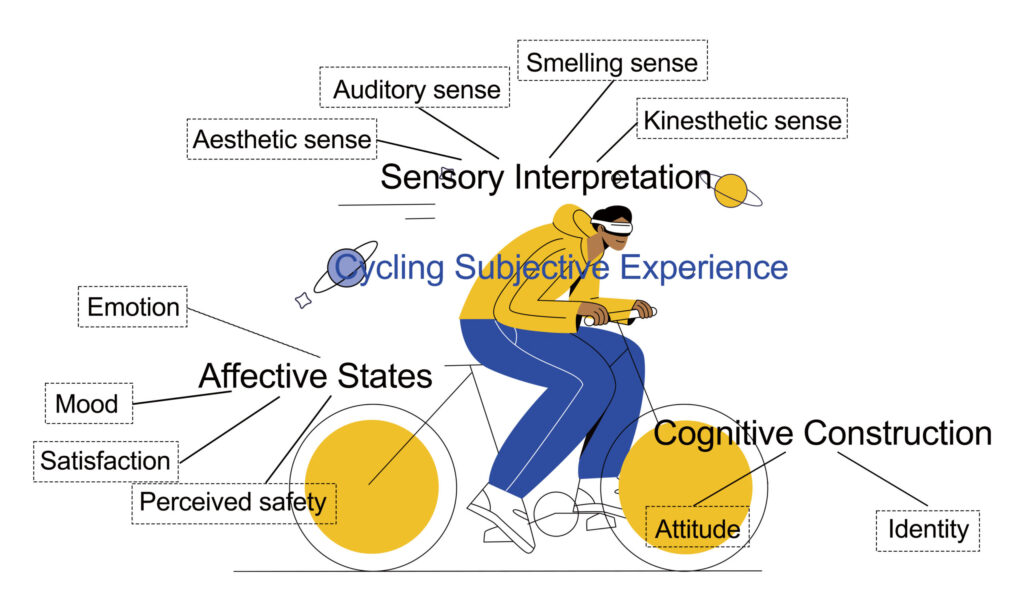Is the prevalence of cycling in cities like Amsterdam or Copenhagen primarily the result of “hard” factors such as bicycle infrastructure and urban form, or of “soft” factors like social norms and values? Cycling researchers – as well as planners and transport researchers more broadly – have long debated the relative importance of physical versus social factors in encouraging cycling. While the bulk of existing research has focused on so-called “hard” factors, an increasing number of studies have concluded that place-specific social norms play at least just as important a role in encouraging cycling in mature cycling contexts.
What, however, do these “local social norms” which encourage cycling actually consist of, and through what mechanisms are they transmitted? Our latest research article seeks to answer this question. As a means of exploring this issue, I decided to talk to international newcomers who had taken up cycling after moving to Amsterdam, asking them about their own cycling experiences and reasons why they had begun to cycle in Amsterdam. Since the newcomers I talked to were new to utilitarian cycling (unlike most local Amsterdamers), I thought they would be in a better position to reflect on the place-specific factors which encourage cycling in Amsterdam. To this end, I carried out in-depth interviews with 28 international newcomers from a variety of countries, ages, and backgrounds.
Based on the analysis of the interviews, I identified the following seven main factors encouraging cycling uptake among newcomers:
- Access to a bicycle is easy and inexpensive
- Cycling is more competitive than other forms of transport
- Cycling is part of the Amsterdam lifestyle
- There exists a social pressure to cycle
- The city is built for cycling
- Cycling is fun and enjoyable
- Cycling is indispensable for grocery shopping and school trips.
As might be expected, some of these factors are fairly obvious. However, other factors which interviewees also considered to be critical – such as the widespread availability of cheap bikes or the usefulness of cycling to carry groceries and children – have not received much attention in previous research. It is also interesting to note that the factors which encouraged cycling among interviewees evolved over time. Typically, interviewees started cycling because they were able find a cheap bike and most of their acquaintances also cycled, but they eventually discovered new reasons to cycle, such as the pleasure and time savings it provided. As some interviewees gradually integrated cycling more and more into their daily routine, they ended up feeling heavily reliant on cycling, raising the question of whether it might make sense to talk about the existence of bicycle dependency (as opposed to car dependency) in a city like Amsterdam.
As I delved into interviewees’ answers, I became increasingly convinced that in many cases it makes little sense to try and distinguish between the role of “hard” and “soft” factors in encouraging cycling. More often than not, the physical and social factors that encourage cycling are inextricably linked. The fact that the city feels “built for cycling”, for instance, is partially the outcome of physical traffic infrastructure, but also of the shared social conventions which govern the use of this infrastructure and tend to give cyclists the upper hand: as various interviewees noted, cycling infrastructure in Amsterdam only works because car drivers in Amsterdam are predominantly cautious and considerate toward cyclists. While many studies in the fields of transport and planning try to isolate the effect of specific factors on cycling, the findings from my interviews suggest that this way of thinking often makes little sense: what makes an attractive cycling environment cannot be reduced to a cumulative sum of discrete factors, but is rather the product of interactions and co-evolutionary feedback processes between different factors.
Critically, the interviews suggest that the majority of the factors which encourage cycling in Amsterdam are at least partly dependent on the existence of a critical mass of existing cyclists. In the article, I propose to think of this critical mass of cyclists as a form of human infrastructure which plays a crucial role in reproducing the city’s cycling culture. On the one hand, the critical mass of existing cyclists encourages cycling through social mechanisms, such as by handing over inexpensive bicycles to newcomers and by exercising pressure on them to cycle. On the other hand, this human infrastructure also encourages cycling through its physical presence. Indeed, the critical mass of cyclists moving around Amsterdam forces other road users to defer to cyclists, thereby contributing to make cycling safer and more attractive; moreover, it contributes to creating an atmosphere of conviviality among fellow cyclists, making it a social and enjoyable activity. For cities trying to increase cycling rates, this means that the existence of a small critical mass of cyclists may be essential to gain further traction for cycling.
To cite the academic article: Samuel Nello-Deakin & Anna Nikolaeva (2020) The human infrastructure of a cycling city: Amsterdam through the eyes of international newcomers, Urban Geography, DOI: 10.1080/02723638.2019.1709757



